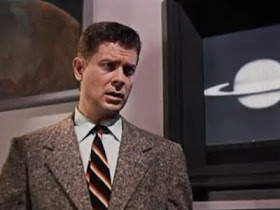July 24, 2011
REVIEW: Invaders From Mars (William Cameron Menzies, 1953)
The wide-eyed child is David MacLean (Jimmy Hunt). He spends his nights looking through the telescope in his room with his kindly father (Leif Erickson), entranced by the possibilities of outer space. After David witnesses a flying saucer's descent to Earth, his parents suddenly act abnormally, to the point that his father exhibits emotion only when he hits David. Of course, that's not his dad anymore - it's a mind-controlling alien working his dad's body like an instrument. David spends the rest of the film learning about and fighting the encroaching aliens, who plan to turn everybody into mindless drones. A nine-year-old saving the world from flying saucers? This literally sounds like the dream of every child of the fifties.
This dreamlike attitude bleeds into much of Invaders From Mars. The hillock behind David's house, constantly seen throughout the film as a pathway to alien control, purposefully looks like a painted landscape. With its soot-black trees and twisting road, the scene looks one step removed from the world of Dr. Caligari.
The police station is notable for its lack of ornamentation and high walls. Later in the film, battle scenes that take place underground feature footage that's re-used with such frequency that the choice stops feeling cheap and begins to feel like a deliberate aesthetic choice. This sense of style keeps the film intriguing and memorable, and the surrogate family David assembles during the movie feels genuine, but other decisions deflate the urgency of the narrative.
In one of the most misguided scenes ever produced for a sci-fi film, David takes a ten-minute break from the action while astronomer Stuart Keltson (Arthur Franz) lectures David and viewers on the growing phenomenon of flying saucers. The scene smashes historical UFO sightings, reckless anti-scientific speculation, and pure fabrication into an explosive collision of nonsense. The film never recovers, and the unsettling paranoia of the first act gives way to gee-golly adventure with unconvincing aliens more suited to a Buck Rogers serial. The reliance on military stock footage further hurts the pull of the story. An obvious cost-saving measure, the images of random soldiers and explosions take up too much time and bring up needless associations with Z-budget "filmmakers" like Bert I. Gordon and Ed Wood.
One could argue that Invasion of the Body Snatchers, released in 1956, borrows its paranoia from Invaders From Mars, with its portrayal of a small town exhibiting distant behavior. Of course, Invaders From Mars came out the same year as It Came From Outer Space, which also featured townspeople under the control of an alien intelligence. That film was based on a Ray Bradbury treatment from 1952, which puts it ahead of Invaders From Mars and The Body Snatchers. Then again, The Body Snatchers ripped off Robert Heinlein's 1951 story The Puppet Masters, which features slugs that attach at the base of the neck. Stokely reminds Casey of this in The Faculty, which isn't a great film, but is more clever than you might remember. At the least, it has the good sense to open to the guitar plucking of Pink Floyd's "Another Brick in the Wall," and, if you think about it, that phrase sums up the theme of this sub-sub-genre just about perfectly.
RATING: C+





No comments:
Post a Comment